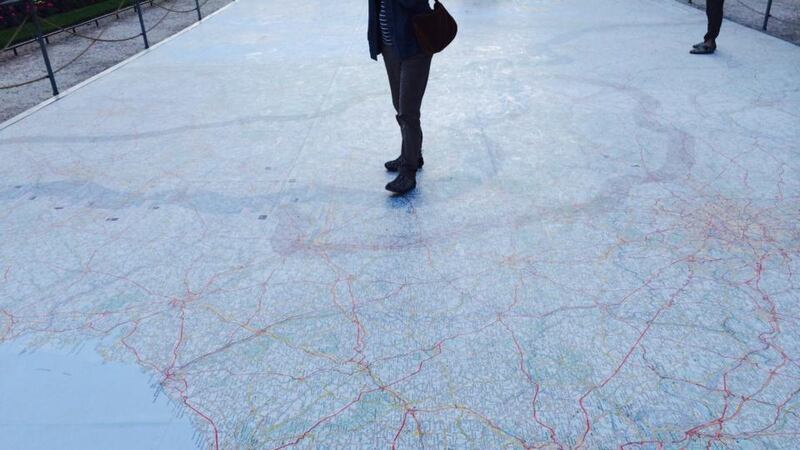As well as enclosing one of the most beautiful parks in Paris, the railings of the Jardin du Luxembourg make for a very prestigious exhibition space. When the sun is shining, they’re better than any indoor gallery.
So the Anglo-Irish photographer Mike St Maur Sheil has been guaranteed an appreciative audience lately for the mammoth series of pictures – 79 in all – that currently extends from the main gate at Boulevard St Michel to the walls of the French senate, the garden’s official owner, some 100 metres away.
His subject is the Great War, or more specifically the battlefields of the Great War, as they appear today, a century on. And this makes for a haunting contrast between the photographs and their surrounds.

Inside the railings, it’s high summer, celebrated in the park by every form of life. The pictures, on the other hand, were shot in all seasons, and mostly amid the pastoral lowlands of northern France and Belgium. Many of them depict snowy or mist-covered scenes in the valleys of the shadow of death.
In fact, war is often a disguised or invisible presence in the exhibition. Some pictures, like the one of Ploegsteert Wood in Belgium, suggest the landscape’s ability to regenerate completely from the tortures of a century ago.
Fiercely contested for most of the war, “Plug Street” (its English nickname) was a source of terror to attackers and defenders alike, including a 26-year-old German soldier called Adolf Hitler. Repeated shelling deprived the woods of every tree. But as Sheil’s picture shows, the forestry has made a big comeback.
Then there’s an aerial photograph of Beaumont-Hamel in the Somme, where the grass may be growing again, but you can still see the trenches and shell-holes underneath it, as a kind of weird topography. From the air, it looks like a cross between a lunar landscape and the Hill of Tara.
The pictured scenes are not confined to northern France and Belgium. They extend to the battlefields of the east, and beyond to Salonika, Palestine, and East Africa. And as well as being geographically inclusive, they also apply parity of esteem to victims.
One of the more eerily beautiful photographs is of a make-shift German cemetery in the Vosges mountains. As the caption says, “honour and respect in death is important to all soldiers”.
So the cemetery, with its hand-carved headstones, was created to evoke memories of the little Bavarian villages from which the dead had come. Later, the soldiers’ remains were removed to official war cemeteries, but the headstones – “each a work of art”– were undisturbed.
Against the backdrop of the 2014 World Cup, interestingly, the only overtly Irish reference in the exhibition involves a football. It belonged to one Frank Edwards, who played for the London-Irish soccer club and brought it with him to the battlefield of Loos in 1915.
There, anticipating George Orwell’s quip about sport and war by three decades, the ball was kicked repeatedly across no-man’s land ahead of the advancing troops.
As for the man who took the pictures, Mike St Maur Sheil is himself often described as Irish, although he jokes that, strictly speaking, he’s a “West Briton”. He was born in Oxford, but of three-quarters Irish ancestry. And when, as a young photographer in 1970, he travelled to Belfast to cover the Troubles, he went as someone who thought of Ireland as “my own country”.
In more recent times, 2002, he won a World Press Photography award for his work on child slavery in Africa. But in official retirement, he has spent the last eight years photographing battle sites, and the finest fruit of that work is now hanging in the Luxembourg Garden.
The show is accompanied by an unusual map – one you can walk on – made by Michelin. The size of a small swimming pool, it displays all the battlefields of the war, and includes the locations of both the Irish peace park at Messines and the Ulster tower at Thiepval.
This may hint at future venues for the exhibition. After Paris, the show moves to St James’s Park, London in August, and then goes on tour. But in 2016, for the Somme Centenary, Sheil would love it to run simultaneously in Dublin and Belfast.
In the meantime, he’d be delighted to hear (via fieldsofbattle1418.org) from sponsors, political or commercial. The sole involvement of the French senate in the project was to lend him their garden railings. If anyone can offer support of a non-metal variety, it would be very welcome.








